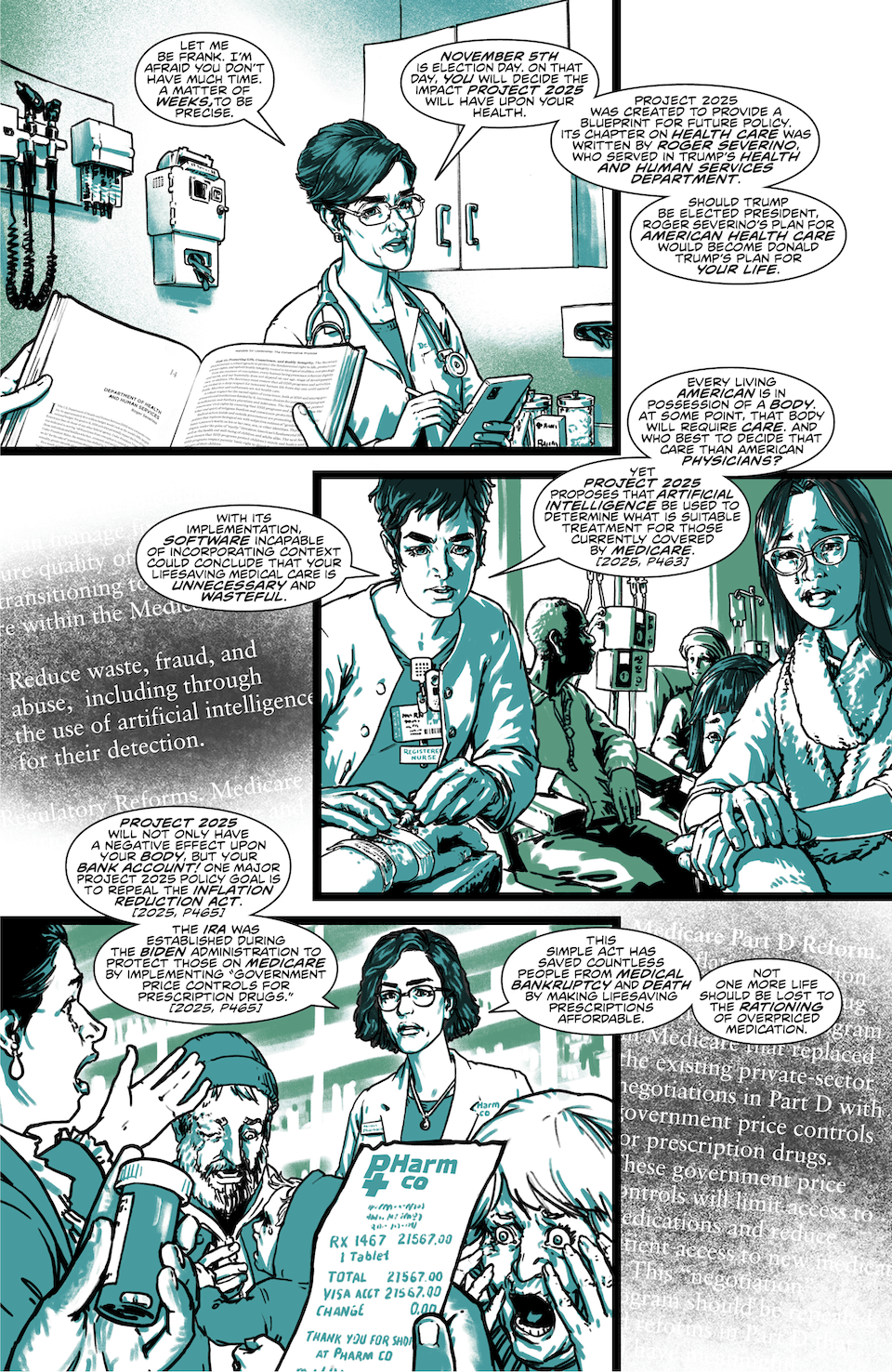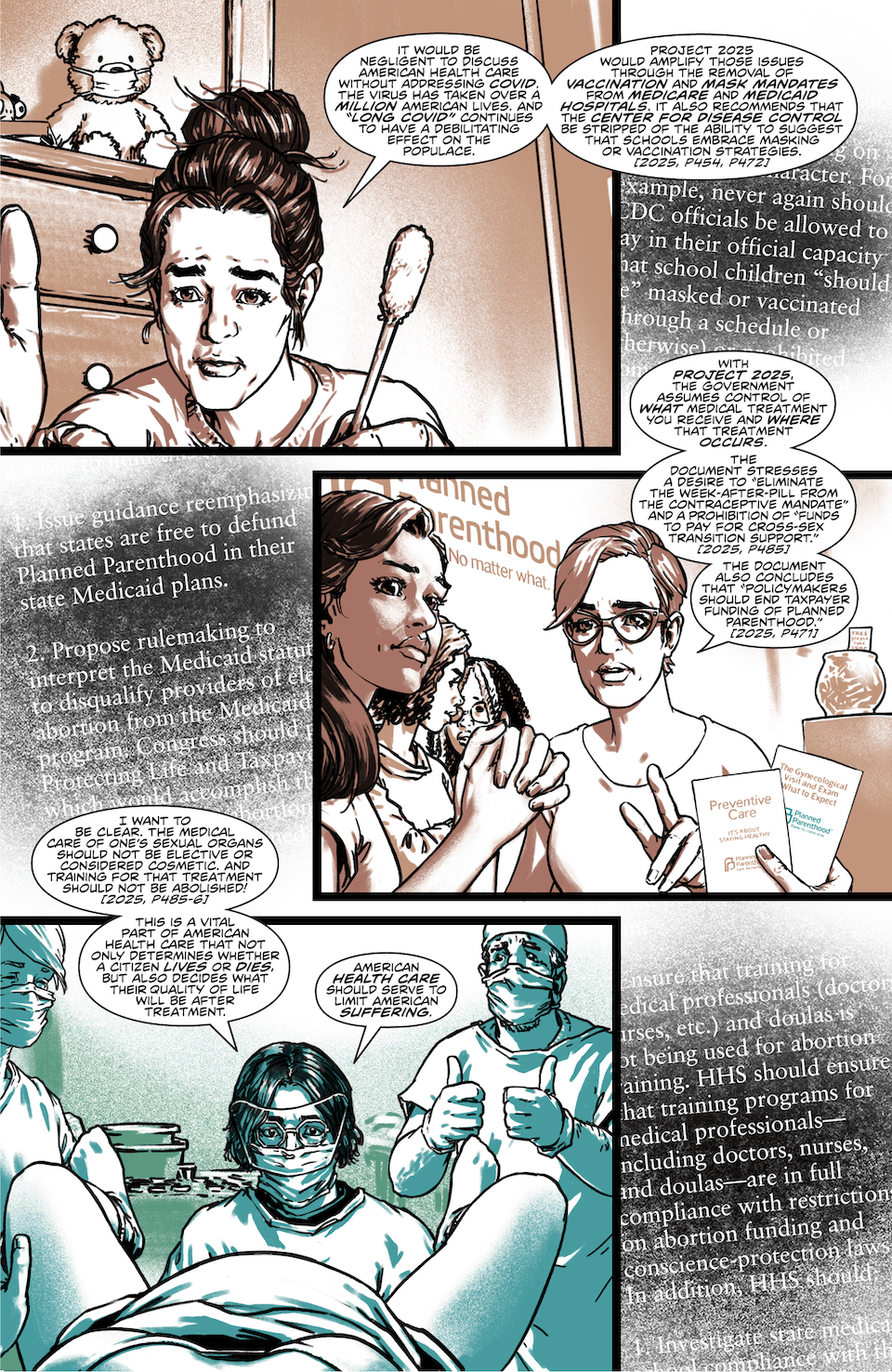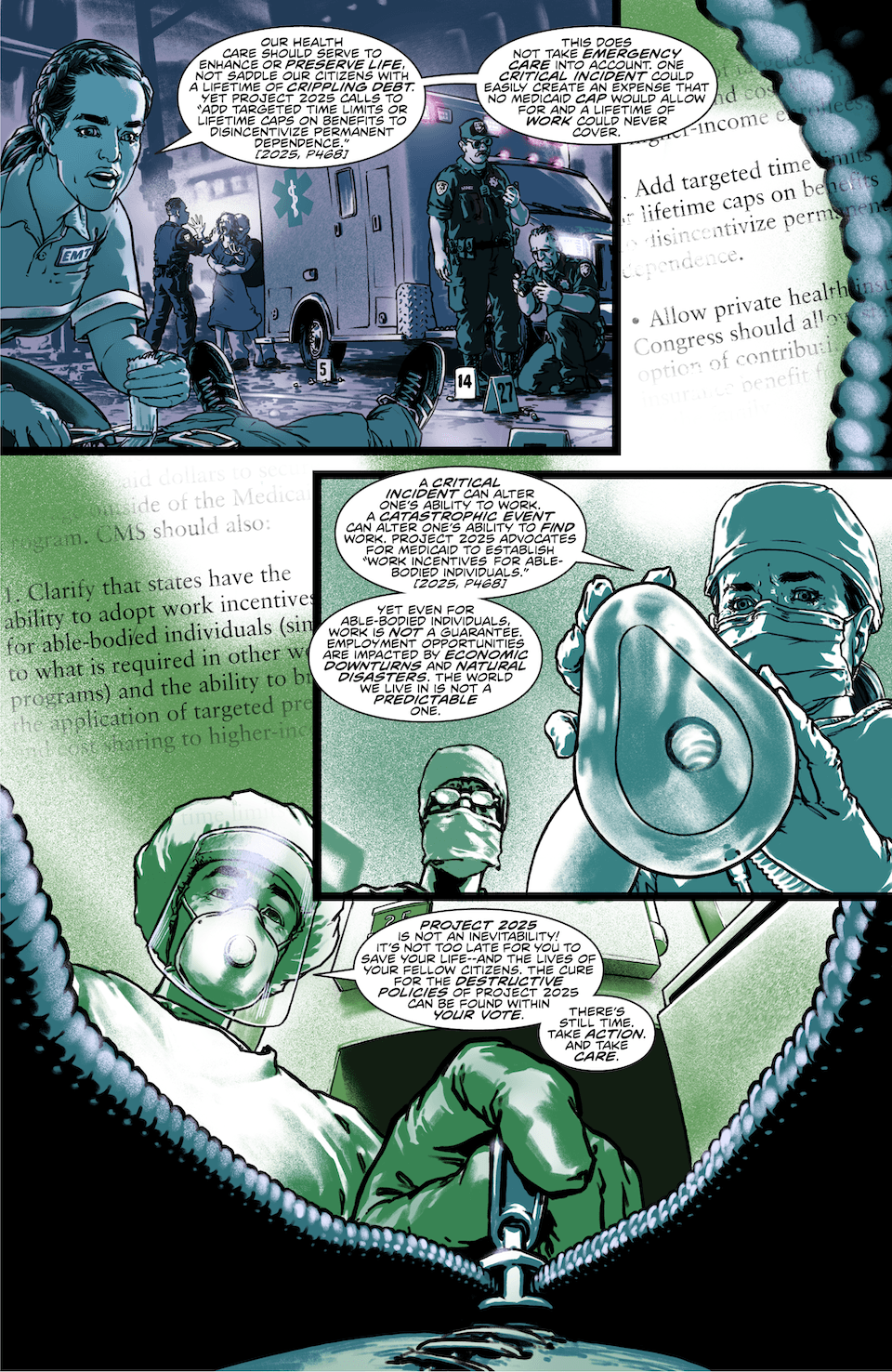American health care should work to reduce American suffering. Project 2025 will increase it.
health Care
Read a full transcript of the comic
HEALTH CARE
PAGE ONE
Panel 1
A stereotypical, fully-stocked doctor’s office, with equipment on the walls and counters. A female doctor with a white lab coat and stethoscope writes on a tablet with a stylus. In the foreground, hands hold an open copy of the Project 2025 document, open to chapter 14: “Department of Health and Human Services.”
DOCTOR: Let me be frank. I’m afraid you don’t have much time. A matter of weeks, to be precise.
DOCTOR: November 5th is Election Day. On that day, you will decide the impact Project 2025 will have upon your health.
DOCTOR: Project 2025 was created to provide a blueprint for future policy. Its chapter on health care was written by Roger Severino, who served in Trump’s Health and Human Services Department.
DOCTOR: Should Trump be elected president, Roger Severino’s plan for American health care would become Donald Trump’s plan for your life.
Panel 2
A chemotherapy unit. A female nurse places an IV into a patient’s hand. Next to her, a woman and child—implicitly the patient’s family—look on with tearful concern. Behind them are several other exhausted cancer patients. To the left of the panel is a snippet of the Project 2025 document’s policy on the use of AI in fraud reduction, as referenced in the panel.
NURSE: Every living American is in possession of a body. At some point, that body will require care. And who best to decide that care than American physicians?
NURSE: Yet Project 2025 proposes that artificial intelligence be used to determine what is suitable treatment for those currently covered by Medicare. [2025, p. 463]
NURSE: With its implementation, software incapable of incorporating context could conclude that your lifesaving medical care is unnecessary and wasteful.
Panel 3
A pharmacy. A female pharmacist looks on at a group of patients, all of whom are panicking over the prices of their prescriptions. One patient holds a bottle containing a single pill in one hand and a receipt in the other. The receipt tells the reader that this single tablet costs $21,565.00. To the right of the panel is a snippet of the Inflation Reduction Act’s Medicare Part D Reform, which is quoted in the panel.
PHARMACIST: Project 2025 will not only have a negative effect upon your body, but your bank account! One major Project 2025 policy goal is to repeal the Inflation Reduction Act. [2025, p. 465]
PHARMACIST: The IRA was established during the Biden administration to protect those on Medicare by implementing “government price controls for prescription drugs.” [2025, p. 465]
PHARMACIST: This simple act has saved countless people from medical bankruptcy and death by making lifesaving prescriptions affordable.
PHARMACIST: Not one more life should be lost to the rationing of overpriced medication.
PAGE TWO
Panel 1
A child’s bedroom. A concerned mother leans toward the reader with a giant nasal swab in her hand, ready to administer a Covid test. Behind her, on top of a dresser, sits a teddy bear wearing a surgical mask. To the right of the panel is a snippet of the Project 2025 document’s policy on vaccination, as referenced in the panel.
MOTHER: It would be negligent to discuss American health care without addressing Covid. The virus has taken over a million American lives. And “Long Covid” continues to have a debilitating effect on the populace.
MOTHER: Project 2025 would amplify those issues through the removal of vaccination and mask mandates from Medicare and Medicaid hospitals. It also recommends that the Center for Disease Control be stripped of the ability to suggest that schools embrace masking or vaccination strategies. [2025, p. 454, p. 472]
Panel 2
A Planned Parenthood clinic. A female technician addresses a group of worried-looking teen girls of various races. One holds a pair of pamphlets—one on “Preventative Care,” and the other on “The Gynecological Visit and Exam: What to Expect.” To the left of the panel is a snippet of the Project 2025 proposal to defund Planned Parenthood, as referenced in the panel.
TECHNICIAN: With Project 2025, the government assumes control of what medical treatment you receive and where that treatment occurs.
TECHNICIAN: The document stresses a desire to “eliminate the week-after-pill from the contraceptive mandate” and a prohibition of “funds to pay for cross-sex transition support.” [2025, p. 485]
TECHNICIAN: The document also concludes that “policymakers should end taxpayer funding of Planned Parenthood.” [2025, p. 471]
Panel 3
A hospital delivery room. A female obstetrician, with mask and face guard, sits at the foot of the bed of a patient with legs spread, about to give birth. Two other medical professionals stand behind the obstetrician, and one is giving two thumbs up. To the right of the panel is a snippet of the Project 2025 document’s policy on abortion training, as referenced in the panel.
OBSTETRICIAN: I want to be clear. The medical care of one’s sexual organs should not be elective or considered cosmetic. And training for that treatment should not be abolished! [2025, p. 485-6]
OBSTETRICIAN: This is a vital part of American health care that not only determines whether a citizen lives or dies, but also decides what that quality of life will be after treatment.
OBSTETRICIAN: American health care should serve to limit American suffering.
PAGE THREE
Panel 1
Outside an ambulance at a crime scene. Police officers secure the scene, taking photos and calming the victim’s worried loved ones members. In the foreground, a female EMT bandages a supine patient, who is implicitly the victim of violence. To the right of the panel is a snippet of the Project 2025 document’s policy on lifetime benefit caps, as quoted in the panel.
EMT: Our health care should serve to enhance or preserve life, not saddle our citizens with a lifetime of crippling debt. Yet Project 2025 calls to “add targeted time limits or lifetime caps on benefits to disincentivize permanent dependence.” [2025, p. 468]
EMT: This does not take emergency care into account. One critical incident could easily create an expense that no Medicaid cap would allow for and a lifetime of work could never cover.
Panel 2
A hospital operating room. A female anesthesiologist in full surgical scrubs holds a gas mask out to the reader, about put them under. Another doctor hovers in the background. To the left of the panel is a snippet of the Project 2025 document’s policy on work incentives, as quoted in the panel.
ANESTHESIOLOGIST: A critical incident can alter one’s ability to work. A catastrophic event can alter one’s ability to find work. Project 2025 advocates for Medicaid to establish “work incentives for able-bodied individuals.” [2025, p. 468]
ANESTHESIOLOGIST: Yet even for able-bodied individuals, work is not a guarantee. Employment opportunities are impacted by economic downturns and natural disasters. The world we live in is not a predictable one.
Panel 3
A morgue. A morgue attendant in full PPE zips up a body bag that the reader is implicitly inside.
MORGUE ATTENDANT: Project 2025 is not an inevitability! It’s not too late for you to save your life—and the lives of your fellow citizens. The cure for the destructive policies of Project 2025 can be found within your vote.
MORGUE ATTENDANT: There’s still time. Take action. And take care.



